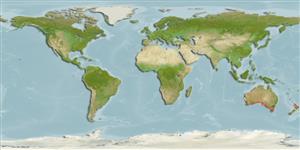>
Eupercaria/misc (Various families in series Eupercaria) >
Sparidae (Porgies)
Etymology: Acanthopagrus: Greek, akantha = thorn + Greek, pagros, a kind of fish (Ref. 45335).
Eponymy: Alfred Dunbavin Butcher (1915–1990) was an Australian zoologist. [...] (Ref. 128868), visit book page.
Environment: milieu / climate zone / Mức độ sâu / distribution range
Sinh thái học
Biển; Nước ngọt; Thuộc về nước lợ gần đáy. Subtropical; 23°S - 44°S, 112°E - 154°E
Indo-Pacific: endemic to southern Australia.
Length at first maturity / Bộ gần gũi / Khối lượng (Trọng lượng) / Age
Chín muồi sinh dục: Lm ?, range 16 - ? cm
Max length : 60.0 cm TL con đực/không giới tính; (Ref. 2156); common length : 24.0 cm TL con đực/không giới tính; (Ref. 2156); Khối lượng cực đại được công bố: 4.0 kg (Ref. 26523); Tuổi cực đại được báo cáo: 29 các năm (Ref. 36820)
Các tia vây lưng cứng (tổng cộng) : 10 - 13; Các vây lưng mềm (tổng cộng) : 10 - 13; Tia cứng vây hậu môn: 3; Tia mềm vây hậu môn: 8 - 10. The upper body can vary from silvery to golden brown, bronze, green or black depending on habitat. Chin and belly are usually white and fins are dusky to greenish black. Dorsal and ventral profiles of adults are similarly convex.
Body shape (shape guide): fusiform / normal; Cross section: compressed.
Endemic in coastal areas, rivers and estuaries of Australia. Most abundant in river mouths and estuaries (Ref. 28468, 28472). Inhabit brackish waters of coastal rivers and lakes, occasionally penetrating fresh water (Ref. 44894). Considered as the only true estuarine sparid in Australia. Larvae and small juveniles are most abundant over seagrass beds in shallow estuarine waters (Ref. 28468, 28472). Spawning period varies considerably between estuaries (Ref. 28468). Remain upstream in sheltered waters to spawn and is not usually found in purely marine habitats (Ref. 44894). Feed on shellfish, worms, crustaceans, small fish and algae. Sold as whole, chilled products in domestic markets (Ref. 6390). One of top angling species in southern Australia (Ref. 6390, 44894), as well as being a delicious table fish (Ref. 2156).
It is not known whether there is any sex inversion in black bream (Ref. 6390).
Kailola, P.J., M.J. Williams, P.C. Stewart, R.E. Reichelt, A. McNee and C. Grieve, 1993. Australian fisheries resources. Bureau of Resource Sciences, Canberra, Australia. 422 p. (Ref. 6390)
IUCN Red List Status (Ref. 130435: Version 2025-1)
Threat to humans
Harmless
Human uses
Các nghề cá: Tính thương mại; cá để chơi: đúng
Các công cụ
Special reports
Download XML
Các nguồn internet
Estimates based on models
Preferred temperature (Tài liệu tham khảo
123201): 14.7 - 20.6, mean 17.6 °C (based on 126 cells).
Phylogenetic diversity index (Tài liệu tham khảo
82804): PD
50 = 0.5000 [Uniqueness, from 0.5 = low to 2.0 = high].
Bayesian length-weight: a=0.01259 (0.01137 - 0.01394), b=3.04 (3.01 - 3.07), in cm total length, based on LWR estimates for this species (Ref.
93245).
Mức dinh dưỡng (Tài liệu tham khảo
69278): 3.5 ±0.53 se; based on food items.
Generation time: 4.1 (3.7 - 6.9) years. Estimated as median ln(3)/K based on 16
growth studies.
Thích nghi nhanh (Tài liệu tham khảo
120179): thấp, thời gian nhân đôi của chủng quần tối thiểu là 4.5 - 14 năm (K=0.11; tm=2-5; tmax=29).
Fishing Vulnerability (Ref.
59153): Moderate vulnerability (41 of 100).
🛈
Nutrients (Ref.
124155): Calcium = 76.4 [42.1, 142.3] mg/100g; Iron = 1.07 [0.62, 1.89] mg/100g; Protein = 20 [19, 21] %; Omega3 = 0.36 [0.25, 0.57] g/100g; Selenium = 21.1 [10.4, 38.9] μg/100g; VitaminA = 9.49 [3.31, 24.31] μg/100g; Zinc = 0.832 [0.594, 1.137] mg/100g (wet weight);
